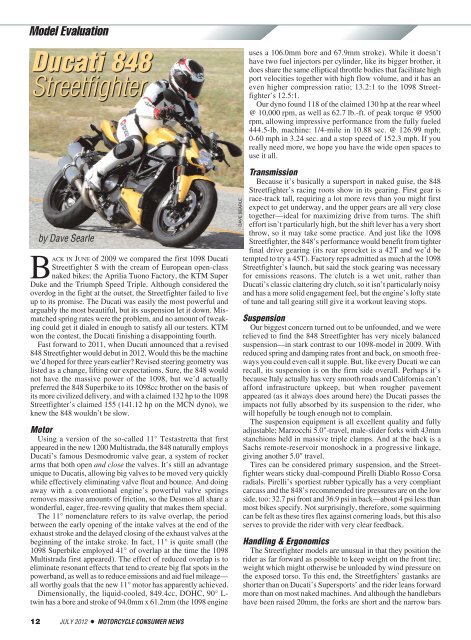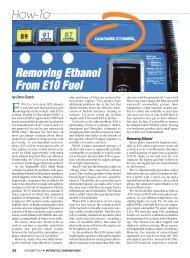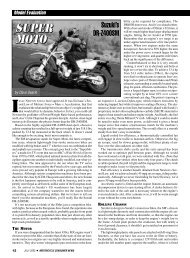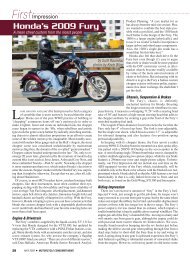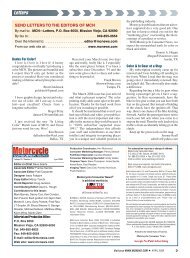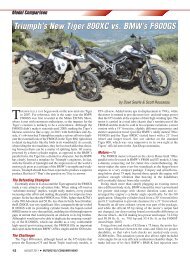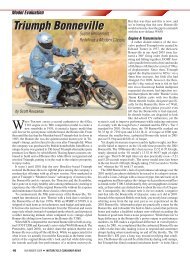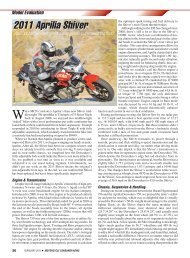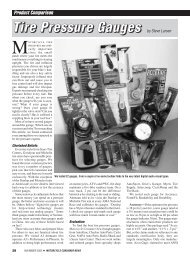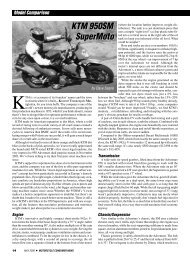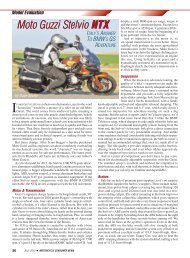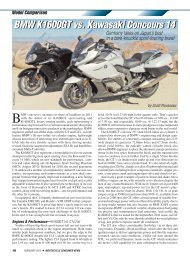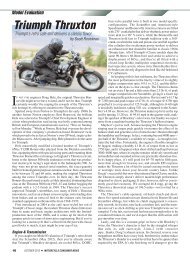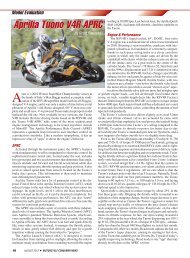Ducati 848 Streetfighter Ducati 848 Streetfighter - Motorcycle ...
Ducati 848 Streetfighter Ducati 848 Streetfighter - Motorcycle ...
Ducati 848 Streetfighter Ducati 848 Streetfighter - Motorcycle ...
You also want an ePaper? Increase the reach of your titles
YUMPU automatically turns print PDFs into web optimized ePapers that Google loves.
Model Evaluation<br />
<strong>Ducati</strong> <strong>848</strong><br />
<strong>Streetfighter</strong><br />
by Dave Searle<br />
BACK IN JUNE of 2009 we compared the first 1098 <strong>Ducati</strong><br />
<strong>Streetfighter</strong> S with the cream of European open-class<br />
naked bikes; the Aprilia Tuono Factory, the KTM Super<br />
Duke and the Triumph Speed Triple. Although considered the<br />
overdog in the fight at the outset, the <strong>Streetfighter</strong> failed to live<br />
up to its promise. The <strong>Ducati</strong> was easily the most powerful and<br />
arguably the most beautiful, but its suspension let it down. Mismatched<br />
spring rates were the problem, and no amount of tweaking<br />
could get it dialed in enough to satisfy all our testers. KTM<br />
won the contest, the <strong>Ducati</strong> finishing a disappointing fourth.<br />
Fast forward to 2011, when <strong>Ducati</strong> announced that a revised<br />
<strong>848</strong> <strong>Streetfighter</strong> would debut in 2012. Would this be the machine<br />
we’d hoped for three years earlier? Revised steering geometry was<br />
listed as a change, lifting our expectations. Sure, the <strong>848</strong> would<br />
not have the massive power of the 1098, but we’d actually<br />
preferred the <strong>848</strong> Superbike to its 1098cc brother on the basis of<br />
its more civilized delivery, and with a claimed 132 hp to the 1098<br />
<strong>Streetfighter</strong>’s claimed 155 (141.12 hp on the MCN dyno), we<br />
knew the <strong>848</strong> wouldn’t be slow.<br />
Motor<br />
Using a version of the so-called 11° Testastretta that first<br />
appeared in the new 1200 Multistrada, the <strong>848</strong> naturally employs<br />
<strong>Ducati</strong>’s famous Desmodromic valve gear, a system of rocker<br />
arms that both open and close the valves. It’s still an advantage<br />
unique to <strong>Ducati</strong>s, allowing big valves to be moved very quickly<br />
while effectively eliminating valve float and bounce. And doing<br />
away with a conventional engine’s powerful valve springs<br />
removes massive amounts of friction, so the Desmos all share a<br />
wonderful, eager, free-revving quality that makes them special.<br />
The 11° nomenclature refers to its valve overlap, the period<br />
between the early opening of the intake valves at the end of the<br />
exhaust stroke and the delayed closing of the exhaust valves at the<br />
beginning of the intake stroke. In fact, 11° is quite small (the<br />
1098 Superbike employed 41° of overlap at the time the 1098<br />
Multistrada first appeared). The effect of reduced overlap is to<br />
eliminate resonant effects that tend to create big flat spots in the<br />
powerband, as well as to reduce emissions and aid fuel mileage—<br />
all worthy goals that the new 11° motor has apparently achieved.<br />
Dimensionally, the liquid-cooled, 849.4cc, DOHC, 90° Ltwin<br />
has a bore and stroke of 94.0mm x 61.2mm (the 1098 engine<br />
12 JULY 2012 ● MOTORCYCLE CONSUMER NEWS<br />
DAVE SEARLE<br />
uses a 106.0mm bore and 67.9mm stroke). While it doesn’t<br />
have two fuel injectors per cylinder, like its bigger brother, it<br />
does share the same elliptical throttle bodies that facilitate high<br />
port velocities together with high flow volume, and it has an<br />
even higher compression ratio; 13.2:1 to the 1098 <strong>Streetfighter</strong>’s<br />
12.5:1.<br />
Our dyno found 118 of the claimed 130 hp at the rear wheel<br />
@ 10,000 rpm, as well as 62.7 lb.-ft. of peak torque @ 9500<br />
rpm, allowing impressive performance from the fully fueled<br />
444.5-lb. machine: 1/4-mile in 10.88 sec. @ 126.99 mph;<br />
0-60 mph in 3.24 sec. and a stop speed of 152.3 mph. If you<br />
really need more, we hope you have the wide open spaces to<br />
use it all.<br />
Transmission<br />
Because it’s basically a supersport in naked guise, the <strong>848</strong><br />
<strong>Streetfighter</strong>’s racing roots show in its gearing. First gear is<br />
race-track tall, requiring a lot more revs than you might first<br />
expect to get underway, and the upper gears are all very close<br />
together—ideal for maximizing drive from turns. The shift<br />
effort isn’t particularly high, but the shift lever has a very short<br />
throw, so it may take some practice. And just like the 1098<br />
<strong>Streetfighter</strong>, the <strong>848</strong>’s performance would benefit from tighter<br />
final drive gearing (its rear sprocket is a 42T and we’d be<br />
tempted to try a 45T). Factory reps admitted as much at the 1098<br />
<strong>Streetfighter</strong>’s launch, but said the stock gearing was necessary<br />
for emissions reasons. The clutch is a wet unit, rather than<br />
<strong>Ducati</strong>’s classic clattering dry clutch, so it isn’t particularly noisy<br />
and has a more solid engagement feel, but the engine’s lofty state<br />
of tune and tall gearing still give it a workout leaving stops.<br />
Suspension<br />
Our biggest concern turned out to be unfounded, and we were<br />
relieved to find the <strong>848</strong> <strong>Streetfighter</strong> has very nicely balanced<br />
suspension—in stark contrast to our 1098-model in 2009. With<br />
reduced spring and damping rates front and back, on smooth freeways<br />
you could even call it supple. But, like every <strong>Ducati</strong> we can<br />
recall, its suspension is on the firm side overall. Perhaps it’s<br />
because Italy actually has very smooth roads and California can’t<br />
afford infrastructure upkeep, but when rougher pavement<br />
appeared (as it always does around here) the <strong>Ducati</strong> passes the<br />
impacts not fully absorbed by its suspension to the rider, who<br />
will hopefully be tough enough not to complain.<br />
The suspension equipment is all excellent quality and fully<br />
adjustable; Marzocchi 5.0"-travel, male-slider forks with 43mm<br />
stanchions held in massive triple clamps. And at the back is a<br />
Sachs remote-reservoir monoshock in a progressive linkage,<br />
giving another 5.0" travel.<br />
Tires can be considered primary suspension, and the <strong>Streetfighter</strong><br />
wears sticky dual-compound Pirelli Diablo Rosso Corsa<br />
radials. Pirelli’s sportiest rubber typically has a very compliant<br />
carcass and the <strong>848</strong>’s recommended tire pressures are on the low<br />
side, too: 32.7 psi front and 36.9 psi in back—about 4 psi less than<br />
most bikes specify. Not surprisingly, therefore, some squirming<br />
can be felt as these tires flex against cornering loads, but this also<br />
serves to provide the rider with very clear feedback.<br />
Handling & Ergonomics<br />
The <strong>Streetfighter</strong> models are unusual in that they position the<br />
rider as far forward as possible to keep weight on the front tire;<br />
weight which might otherwise be unloaded by wind pressure on<br />
the exposed torso. To this end, the <strong>Streetfighter</strong>s’ gastanks are<br />
shorter than on <strong>Ducati</strong>’s Supersports’ and the rider leans forward<br />
more than on most naked machines. And although the handlebars<br />
have been raised 20mm, the forks are short and the narrow bars
are still mounted quite low. They’re also bent down, like clip-ons.<br />
The net effect is that you don’t have the leverage to steer easily,<br />
and the bike takes more work to ride than average. If it were ours,<br />
we’d change the bars for something flatter,1"-higher, 2"-wider<br />
and 1"-farther back. In fact, the seating position is so extreme<br />
that you don’t have to lean very far to look straight down the<br />
front fork.<br />
While this rider-forward set-up might be necessary for handling<br />
at the speeds the machine could do on a racetrack, they definitely<br />
impact its feel at saner street speeds. Given a constant<br />
radius corner at steady speed, the front end will feel as if it is<br />
pushing to the outside, and with the low pressure, soft sidewall<br />
tires, you can feel this as greater front tire slip angle. To ride the<br />
<strong>Streetfighter</strong> quickly on a twisty road thus requires a particular<br />
riding style. To avoid front end push, the rider learns to take a wide<br />
outside entry line and to stay on the gas, to keep both ends balanced.<br />
While this is good cornering technique in general, most<br />
bikes don’t require this technique, but the <strong>Streetfighter</strong> does.<br />
This style also demands a rider who can ride like this without<br />
hesitation, never attempting mid-corner changes of velocity, as<br />
any backing off the gas or braking will throw too much weight<br />
forward, and the bike also wants to stand up under heavy braking,<br />
further increasing steering effort.<br />
It’s true that the steering<br />
geometry has changed and <strong>Ducati</strong><br />
now quotes a rake and trail of<br />
24.5°/4.05", rather than the<br />
25.6°/3.65" of the ’09 1098 <strong>Streetfighter</strong>.<br />
As the wheelbase is listed<br />
as the same 58.1", the new<br />
machine’s steering head has obviously<br />
been extended. But, unlike<br />
our ’09 1098 <strong>Streetfighter</strong> S, a<br />
steering damper is not standard<br />
and isn’t necessary—it’s stable<br />
even at its 152.3 mph top speed.<br />
Also unusual in this class, which<br />
tends to emphasize style more than<br />
rider comfort, the <strong>Streetfighter</strong>’s<br />
seat is actually very supportive,<br />
with a broad back section, thin but<br />
effective upholstery and a narrow front that makes reaching the<br />
ground from its 33" height easier. The pillion portion, on the<br />
other hand, seems designed so the owner can offer rides around<br />
the block to small children.<br />
Braking<br />
The original 1098 <strong>Streetfighter</strong>s were given MotoGP-grade<br />
brakes—so sudden and powerful that even two fingers on the<br />
brake lever were asking for trouble. Complaints at its Spanish<br />
intro were met with the suggestion that the “rain” pads were less<br />
grabby, so we made sure to have these fitted when we road-tested<br />
the bike in 2009, and it appears they are now standard equipment.<br />
With these pads, the rider needs a firmer squeeze, but the<br />
braking power is not diminished and the control is infinitely<br />
better. In fact, the <strong>848</strong> <strong>Streetfighter</strong>’s brakes make challenging<br />
yourself to stop in a very short distance almost as much fun as<br />
accelerating. While the bike’s weight bias makes lifting the rear<br />
wheel easy, it remains balanced from side-to-side, allowing controllable<br />
stoppies, and its 112.9' best stop is exceptionally good.<br />
Riding Impression<br />
The experience of riding the <strong>848</strong> <strong>Streetfighter</strong> is as much about<br />
style as speed. The bike is a work of art, the sort of two-wheeled<br />
lust object that you simply cannot walk past without pausing to<br />
study its lines and exquisite detailing. Every place we stopped for<br />
gas or food, we got compliments. And when the engine is fired up,<br />
the impression is complete—not only is the bike exotic-looking,<br />
it’s clearly powered by an exotic motor—a quick-revving,<br />
snarling beast with bazookas for mufflers. That it behaves so well<br />
when it’s not clawing for that last bit of ultimate speed and can<br />
actually cruise down the highway smoothly purring at 4000 rpm<br />
is a testament to its incredible Marelli electronic engine control—<br />
a welcome trickle-down from MotoGP. The engine has very generous<br />
torque, so you don’t really need to rev it very hard to go<br />
quickly, but if you do, the engine sounds just like the ones that<br />
Troy Bayliss and Carlos Checa have used to whip the Superbike<br />
world, with a hard, flat, staccato wail of combustion. And when<br />
you’re obliged to downshift and brake, the engine responds with<br />
a tympany of rim shots and popping, signaling its raw energy.<br />
If you are immune to such charms, you might as well look<br />
elsewhere for a ride, thoroughbreds just aren’t your style.<br />
Instruments & Controls<br />
<strong>Ducati</strong> hasn’t just put together a beautiful ride, but it has<br />
endowed it with a plethora of electronics for your information<br />
and self-preservation. The instrument panel is cleanly configured<br />
and displays a wealth of real-time<br />
data as well as allowing you to<br />
adjust the eight-position traction<br />
control when stopped, which just<br />
might prevent an overenthusiastic<br />
owner from high-siding his pride<br />
and joy.<br />
As for the controls, both the<br />
clutch and front brake master<br />
cylinders are Brembo radialpump<br />
designs, which provide for<br />
the most linear possible relationship<br />
between the fingers and the<br />
slave pistons, optimizing control<br />
feel. And <strong>Ducati</strong> has fixed the one<br />
serious ergonomic issue we noted<br />
on the original <strong>Streetfighter</strong>; interference<br />
from the bulging heat<br />
shield behind the brake pedal. The<br />
right footpeg is now spaced outboard an additional 10mm for<br />
more comfort, although this can create boot-grinding clearance<br />
issues during track sorties.<br />
DAVE SEARLE<br />
Attention To Detail & Value<br />
Each of us has our favorite details in the masterpiece of styling<br />
that is the <strong>Streetfighter</strong>, so it scores off the charts in this category.<br />
However, we did find one little blemish: the small hole in<br />
the single-sided swingarm meant to provide access to the shock’s<br />
rebound adjuster was misaligned, frustrating our efforts to try<br />
tuning the stock setting. No big deal. Get a long screwdriver.<br />
Priced at $12,995 with traction control standard, the <strong>848</strong> <strong>Streetfighter</strong><br />
is expensive, but not out of line with European competitors<br />
like the $11,999 Aprilia Dorsoduro 1200; $11,999 Triumph<br />
675 Street Triple R; or the $11,399 BMW F800R ABS.<br />
Bottom Line<br />
If Italian supercars are beyond your means, you can still<br />
dazzle one and all with a <strong>Ducati</strong> <strong>Streetfighter</strong> <strong>848</strong>—particularly<br />
stunning in metallic Lamborghini yellow, like our test bike. It<br />
isn’t the easiest ride in town, and keeping it in high performance<br />
rubber and tuned to perfection will demand some disposable<br />
income, but few machines can command such attention. Is it for<br />
you? We suspect you already know the answer.<br />
Visit us at WWW.MCNEWS.COM ● JULY 2012 13
Model Evaluation<br />
Above: The <strong>848</strong> <strong>Streetfighter</strong>’s<br />
Testastretta motor has a reduced 11°<br />
of valve overlap for better driveability,<br />
mileage and emissions. With 118 hp<br />
and 62.7 lb.-ft. of torque, the motor is<br />
very potent and its sound matches the<br />
<strong>Streetfighter</strong>’s sexy appearance. A wet<br />
rather than dry clutch gives better<br />
modulation, but its tall gearing still<br />
makes standing starts a challenge.<br />
DAVE SEARLE PHOTOS<br />
TESTERS’ LOG<br />
I appreciated <strong>Ducati</strong>’s <strong>Streetfighter</strong> S when we sampled it in<br />
2009, but I chose it last despite its powerhouse engine, braking<br />
that could stop the earth’s rotation and rocket-on-rails<br />
handling prowess. Its uncompliant suspension and wrist-wrenching<br />
handlebar were not endearing qualities. The <strong>848</strong> <strong>Streetfighter</strong><br />
still possesses one of these flaws, but I like it much better<br />
than the S. The <strong>848</strong>’s Testastretta L-twin delivers exhilarating<br />
performance that’s most enjoyable when you keep it singing at<br />
high rpm. Its Marzocchi fork and Sachs shock impart a firm feel<br />
like the S, but at least I was able to dial them in to my satisfaction,<br />
unlike the S’ high-dollar Öhlins. The two models share a<br />
razor-sharp handling character that only seems to get better<br />
the harder you push it. And like the S, the <strong>848</strong>’s brakes are stellar.<br />
My only gripe? The <strong>848</strong>’s handlebar bend flat kills my wrists,<br />
even during very short rides. If it were mine, I’d replace the bar with<br />
a more “streetfighter appropriate,” motocross-style handlebar,<br />
a cheaper fix than modifying already expensive suspension.<br />
—Scott Rousseau<br />
14 JULY 2012 ● MOTORCYCLE CONSUMER NEWS<br />
Right: Like the handlebars,<br />
the dash is mounted<br />
low where it’s not so<br />
easy to read at a glance,<br />
but the information it<br />
provides is very complete:<br />
DTC settings, trip<br />
computer functions, a<br />
clock, lap timer, battery<br />
voltage, ambient temperature<br />
and the usual tach,<br />
speedo, odo and trips.<br />
Left: The <strong>Streetfighter</strong>’s enormous exhaust pipes<br />
and stacked silencers shout performance, and the<br />
machine delivers. The pillion seat is minimal, and<br />
we can’t imagine a passenger staying comfortable<br />
for long while seated on its lofty perch.<br />
Right: Thankfully, the new <strong>848</strong> has different steering<br />
geometry and suspension settings than the first<br />
1098 version. The set-up is still firm overall but<br />
works very well. Less aggresive brake pads are<br />
now standard, and stops are exceptionally short.<br />
The Pirelli sport tires have tenacious grip and feel<br />
but use low pressures and do squirm noticeably.<br />
Left: The handlebars are low, narrow<br />
and angled down, reducing leverage<br />
and adding to the front-end heavy<br />
feel. Radial-pump master cylinders<br />
provide excellent control feel to the<br />
brakes and clutch. The mirrors are<br />
wide but are not vibration free, compromising<br />
their usefulness. The<br />
rider’s seat is broad at the back for<br />
good support and comfort.<br />
Although the original <strong>Streetfighter</strong>’s Spanish introduction<br />
was years ago, immediately after hopping on the new <strong>848</strong> <strong>Streetfighter</strong><br />
I could tell that a lot had changed. While this motorcycle<br />
has not deviated far from its roots—dramatic styling, a forward<br />
seating position above a front end that literally disappears<br />
beneath the instrument cluster and, of course, those mighty<br />
Brembo brakes, its ride and handling are very different.<br />
Our testing revealed that its tall gearing will prevent the <strong>848</strong><br />
from being a 1/4-mile demon, but its instant throttle response<br />
and short shift throws make it a natural for exploiting acceleration.<br />
Its traction is impressive, too, and I could press Pirelli’s latest<br />
Diablo Rosso Corsas into hard cornering action almost<br />
immediately. And I loved the fact this <strong>Ducati</strong> comes equipped with<br />
traction control, which I feel is a great advantage.<br />
This motorcycle responds to rider inputs like few others; it<br />
loves to go, stop and turn, all with <strong>Ducati</strong>’s trademark competence.<br />
I would happily own one in a New York second—but mine<br />
would have to be red or black.... —Danny Coe
2012 <strong>Ducati</strong> <strong>848</strong> <strong>Streetfighter</strong><br />
SPECIFICATIONS AND PERFORMANCE DATA<br />
ENGINE<br />
Type:.......... Liquid-cooled, 90° L-twin<br />
Valvetrain: .... DOHC, 4 valves per cyl.,<br />
Desmodromic actuation, shimadjusted<br />
valve clearance<br />
Displacement: ........................849.4cc<br />
Bore/stroke: ................94.0 x 61.2mm<br />
Comp. ratio: ............................13.2:1<br />
Fueling: ..Marelli EFI, elliptical throttle<br />
bodies<br />
Exhaust: ......................2-into-1-into-2<br />
DRIVE TRAIN<br />
Transmission:........................6-speed<br />
Final drive:..................................chain<br />
RPM @ 65 mph*/rev limiter:4220/10,800<br />
*actual, not indicated<br />
DIMENSIONS<br />
Wheelbase: ................................58.1"<br />
Rake/trail:..........................24.5°/4.05"<br />
Ground clearance: ......................4.75"<br />
Seat height: ................................33.0"<br />
GVWR: ..................................860 lbs.<br />
Wet weight: ........................444.5 lbs.<br />
Carrying capacity: ..............415.5 lbs.<br />
SUSPENSION<br />
Front: .. Marzocchi 43mm, male slider<br />
telescopic forks, adj. preload, comp.<br />
and rebound damping, 5.0" travel<br />
Rear: Sachs monoshock with progressive<br />
linkage, adj. preload, comp. and<br />
reb. damping,5.0" travel<br />
BRAKES<br />
Front:Dual 320mm semi-floating discs,<br />
Brembo four-piston, radial-mount<br />
calipers<br />
Rear: ..............................245mm disc,<br />
two-piston floating caliper<br />
TIRES & WHEELS<br />
Front:......120/70ZR17 M/C58W Pirelli<br />
Diablo Rosso Corsa on 3.50" x 17"<br />
wheel<br />
Rear: ......180/60ZR17 M/C75W Pirelli<br />
Diablo Rosso Corsa on 5.50" x 17"<br />
wheel<br />
ELECTRICS<br />
Battery: ..............................12V, 10Ah<br />
Ignition:..............................Digital TCI<br />
Alternator Output:......................480W<br />
Headlight: ..............................60/55W<br />
FUEL<br />
Tank capacity: ........................4.4 gal.<br />
Fuel grade: ..........................Premium<br />
High/low/avg. mpg: ....54.2/31.5/41.1<br />
A<br />
B<br />
C 26.25"<br />
D<br />
E<br />
61.75"<br />
ERGONOMICS TEMPLATE<br />
65.0"<br />
52.5"<br />
52.0"<br />
38.5"<br />
14.2"<br />
MISCELLANEOUS<br />
Instruments: ......Digital speedo, tach,<br />
odo, 2 tripmeters, lap timer, clock,<br />
ambient and coolant temps, DTC status,<br />
range to empty, lap timer, battery<br />
voltage<br />
Indicators: .. hi-beam, t/s, neutral, rev<br />
limiter, low fuel, scheduled maint.,<br />
DTC and DDA levels, oil pressure, EFI<br />
fault,<br />
MSRP: ..................................$12,995<br />
Routine service interval:........7500 mi.<br />
Valve adj. interval: ................7500 mi,<br />
Warranty: ............2 years, unltd. miles<br />
Colors:Dark Stealth/Black, Yellow, Red<br />
33.0"<br />
TEST NOTES<br />
PICKS<br />
Dazzling style and detailing<br />
Potent performance and exotic sound<br />
Awesome brakes<br />
20.0"<br />
35.8"<br />
F G H I J<br />
Low end <br />
Mid-range <br />
Top end <br />
The <strong>848</strong> Testastretta’s<br />
superbike bloodlines are<br />
only thinly disguised.<br />
Very highly tuned, its hot<br />
rod heart has been tamed<br />
by advanced electronics.<br />
It’s deceptively quick, yet<br />
it will run very smoothly<br />
above 4000 rpm. Exotic,<br />
yes, but civilized, too.<br />
PANS<br />
Low, narrow handlebars require higher steering efforts<br />
Lack of wind protection is tiring on fast freeway runs<br />
Tall gearing makes slow traffic tedious<br />
Horizontal (nose to)<br />
A: Passenger seat<br />
(middle). B: Rider<br />
seat (middle). C:<br />
Handgrip (center).<br />
D: Passenger footpeg<br />
(center). E: Rider<br />
footpeg (center).<br />
Vertical (ground to)<br />
F: Handlebar (center).<br />
G: Rider footpeg<br />
(top). H: Rider<br />
seat (lowest point).<br />
I : Passenger peg<br />
(top). J: Passenger<br />
seat (middle).<br />
DYNAMOMETER DATA<br />
SAE CORRECTED REAR-WHEEL HORSEPOWER<br />
PERFORMANCE<br />
Measured top speed ......152.3 mph<br />
0–1/4 mile..................10.88 sec.<br />
..........................@ 126.99 mph<br />
0–60 mph ....................3.24 sec.<br />
0–100 mph ..................7.03 sec.<br />
60–0 mph ........................112.9'<br />
Power to Weight Ratio ........1:3.76<br />
Speed @ 65 mph indicated ....61.6<br />
MC RATING SYSTEM<br />
EXCELLENT<br />
VERY GOOD<br />
GOOD<br />
FAIR<br />
POOR <br />
–––– Middleweight Naked –––<br />
Engine <br />
<br />
Transmission <br />
<br />
Suspension <br />
<br />
Brakes <br />
<br />
Handling <br />
<br />
Ergonomics <br />
<br />
Riding Impression <br />
<br />
Instruments/Controls <br />
<br />
Attention to Detail <br />
<br />
Value <br />
<br />
OVERALL RATING <br />
<br />
118.08 hp<br />
RPM, THOUSANDS<br />
•<br />
62.68 lb.-ft.<br />
STANDARD MAINTENANCE<br />
Item Time Parts Labor<br />
Oil & Filter ................0.5 ..........$81.96 ..........$40.00<br />
Air Filter....................0.5 ..........$84.28 ..........$40.00<br />
Valve Adjust..............4.0 ..........$52.90 ........$320.00<br />
Battery Access..........0.5 ............MF ..............$40.00<br />
Final Drive ................0.1 ..................................$8.00<br />
R/R Rear Whl. ..........0.6 ................................$48.00<br />
Change Plugs............0.6 ..........$87.98 ..........$48.00<br />
Synch EFI..................1.0 ................................$80.00<br />
Totals 7.8 $307.12 $624.00<br />
Visit us at WWW.MCNEWS.COM ● JULY 2012 15<br />
•<br />
SAE CORRECTED REAR-WHEEL TORQUE, LB. FT.<br />
* MCN has changed the estimated labor rate to $80 starting March 2007


